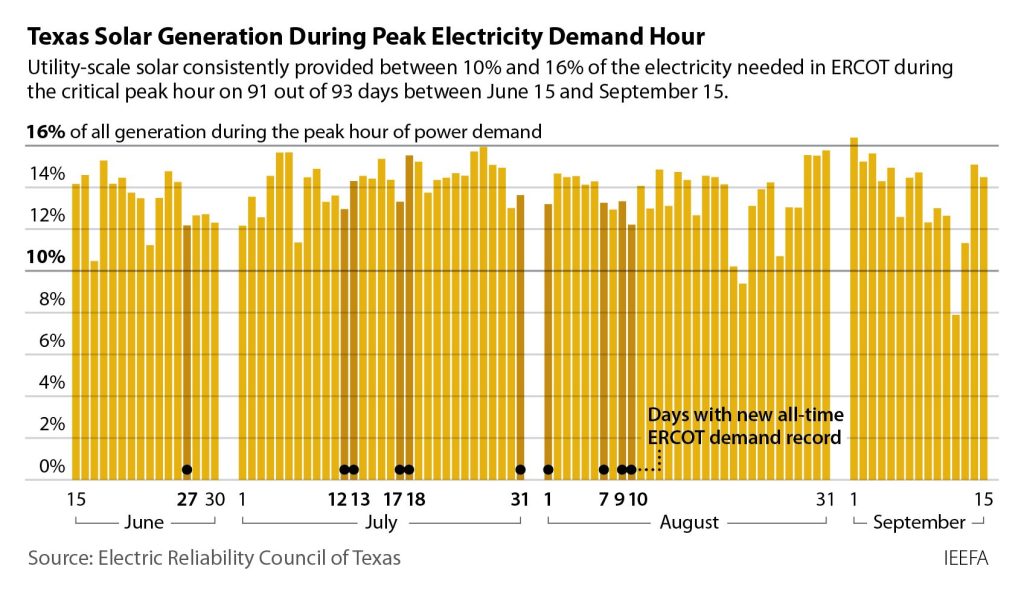
Utility-scale solar and wind kept the Texas grid online during 2023’s record-breaking summer heat, according to IEEFA – here’s how it breaks down.
Texas is a solar powerhouse
Researchers from the Institute for Energy Economics and Financial Analysis (IEEFA) crunched data from ERCOT, which operates the Texas grid. The researchers found that from June 15 through September 15 – Texas’s highest power-use period – solar provided more than 10% of the peak electric demand on 91 of those 93 days and averaged 13.8% across all 93 days. (And let’s note that peak electricity demand time isn’t even peak solar power generation time.)

The Texas grid got a boost from solar because its growth in the state has skyrocketed in the last five years – the Lone Star State is now No. 2 in the US for installed solar, according to the Solar Energy Industries Association.

In 2019, according to IEEFA, utility-scale solar provided just over 500,000 megawatt-hours (MWh) of power in July and again in August. That supplied just a bit more than 1% of all electricity needed. In 2023, however, utility-scale solar delivered more than 3.9 million MWh each month – that’s about 8% of the electricity Texas needed.
Beyond that, utility-scale solar is increasing so rapidly in Texas that the state is expected to bump California out of the No. 1 spot over the next five years, with a growth projection of 40,579 MW. (What’s more, rooftop solar isn’t even included in these numbers.)
Solar, wind, and the Texas grid this summer
The Texas grid set 10 new demand records this summer, thanks to record-breaking and relentless heatwaves. The most recent demand record was set on August 10, when 85,464 megawatts (MW) of power were needed during peak time. That was up 6.6% from 2022’s all-time record high on July 20, 2022, when 80,148 MW was needed.
So here’s where it gets interesting: According to IEEFA, solar generation on August 10 this year was 10,435 MW, up 2,355 MW from the 8,080 MW produced on the 2022 record date of July 20. That means that solar supplied nearly half of the additional power needed by ERCOT.
And it would be remiss to not include wind power generation during 2023’s sweltering summer, especially seeing how Texas is No. 1 in that clean energy capacity category. The analysts note that on August 10, 2023, wind power generation was 9,553 MW during the peak hour, compared with 7,369 MW on July 20, 2022. That’s an increase of 2,184 MW.
This means that wind and solar produced 4,539 MW more power than when the previous power demand record was set – so they supplied 85% of all the extra power needed.
(However, as Electrek reported in July, ERCOT needs to do some serious grid upgrades to harness every bit of that power.)
And what’s more, the more than 3,500 MW of installed long-duration energy storage capacity also played a crucial role in keeping Texas’s lights on this past summer because the large batteries store clean energy generated during lower demand periods, and they discharge the power when it’s needed. ERCOT estimates that about 10,000 MW of battery storage capacity will come online commercially by the end of June 2024.
Top comment by Philip234
Here you can see what actually happened (snapshot from a random day on July 20 this year). The combination of solar and wind priovided a highly stable 15k - 20k MWh with wind picking up night load and solar filling in the day. Chart was a screen shot from the ERCOT real time dashboard.
As IEEFA’s Seth Feaster and Dennis Wamsted write:
The figures undercut a key argument used by fossil fuel advocates when talking about renewables – that they are not reliable or predictable. The data proves otherwise. Solar is both reliable and predictable.
Graphs: IEEFA
To limit power outages and make your home more resilient, consider going solar with a battery storage system. In order to find a trusted, reliable solar installer near you that offers competitive pricing, check out EnergySage, a free service that makes it easy for you to go solar. They have hundreds of pre-vetted solar installers competing for your business, ensuring you get high-quality solutions and save 20-30% compared to going it alone. Plus, it’s free to use, and you won’t get sales calls until you select an installer and share your phone number with them.
Your personalized solar quotes are easy to compare online, and you’ll get access to unbiased Energy Advisers to help you every step of the way. Get started here.
FTC: We use income earning auto affiliate links. More.




Comments